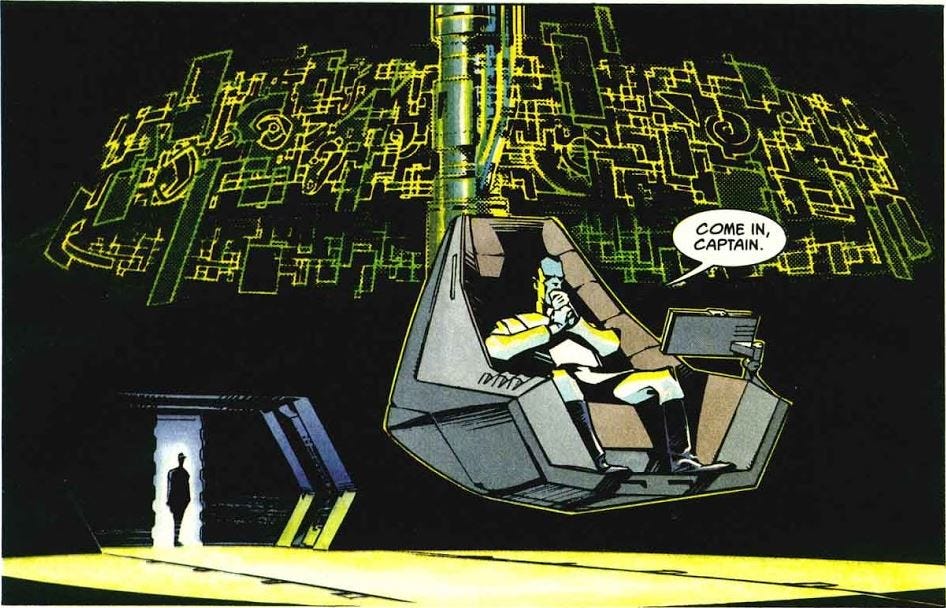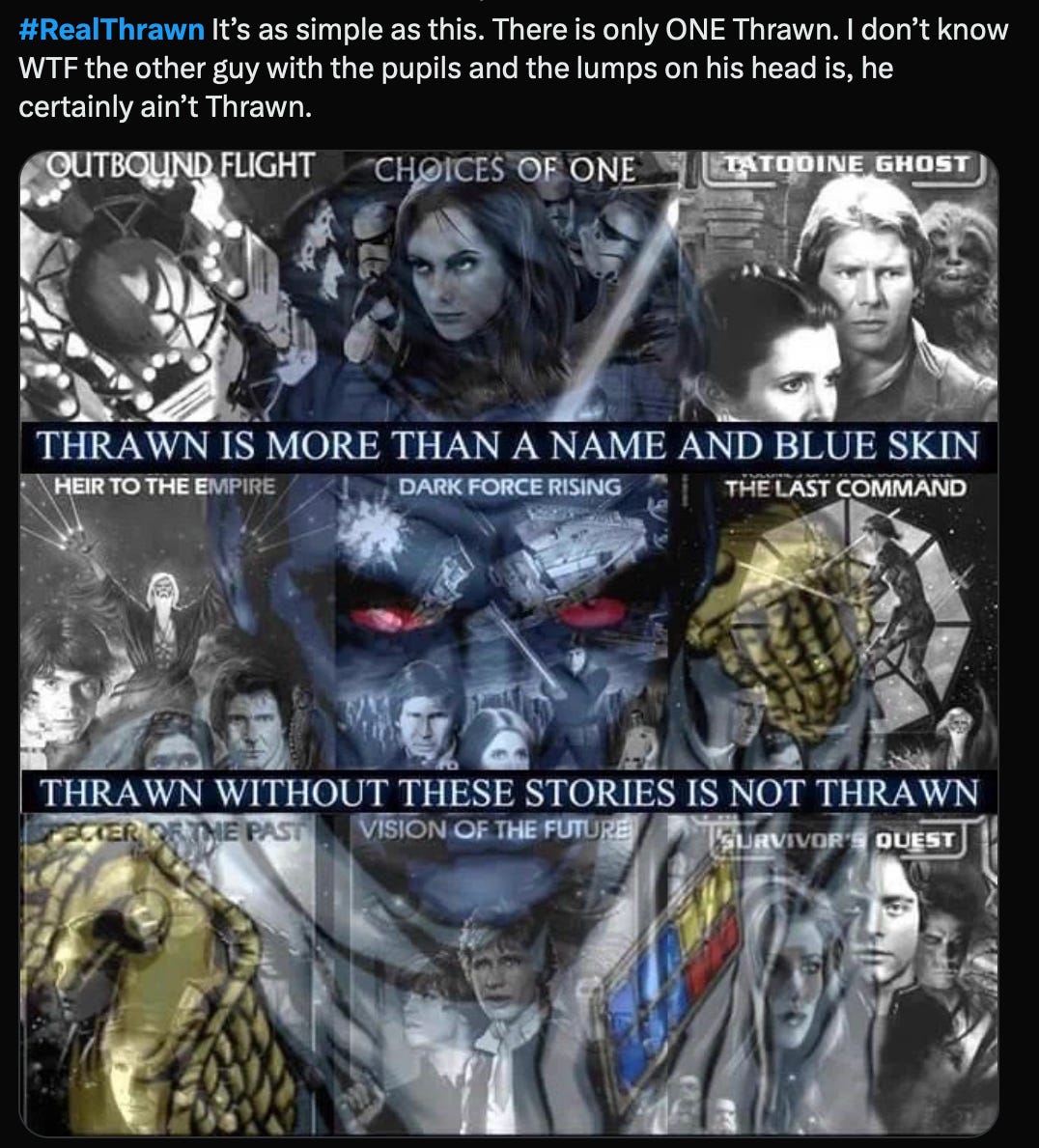Thrawn: Diabolical Mastermind Or Adorable Little Blueberry?
A primer on the Grand Admiral before his live-action debut
Whether you show a kid a picture of Adam West dancing in shiny spandex or Ben Affleck firing a gun in a trench coat, they’ll say the same thing: “Batman!”
Tonight, hopefully, a different detective who collects dark-haired little boys as sidekicks will leap from the page to the screen. Like Bruce Wayne, Grand Admiral Mitth’raw’nuruodo has been illustrated many different ways by comic artists. But unlike Batman, Thrawn has mostly been written by one person (Timothy Zahn) in one format (the novel). So why am I so nervous Ahsoka will get him wrong? Why is there disagreement about how the “real Thrawn” should act?
The answer has to do with his unique history. The character kicked off the Expanded Universe in 1991, exciting a fanbase hungry for Star Wars content after the film series had seemingly ended. Then, in 2016, after Disney relegated those stories to “Legends” status, he reappeared in the cartoon Rebels, followed by six new books.
Batman never sat on the shelf for twenty years. He evolved based on the changing tastes and ideas of a larger comic book industry. His varied screen adaptations reflect those interpretations. Nobody frets about whether Will Arnett’s Lego Batman conforms to Bob Kane and Bill Finger’s original vision from 1938.
Thrawn evolved in the imagination of Star Wars diehards. And at some point that legend outgrew the creator’s intent. Now he arrives on television as the franchise’s most iconic character not originally written for the screen. How Lars Mikkelsen portrays Thrawn will clarify how the franchise treats its lore in the streaming age.
Devil in a New Bomber Jacket
There are certain characteristics—besides blue skin and red eyes—that are taken for granted with Thrawn. His Wikipedia page heavily cites an IGN quotation about how he’s “diabolical, brilliant and ruthless.” The official Star Wars website describes him as being “known for his brilliant strategic mind and ruthlessness.” The description of this Thrawn bomber jacket (which I regret not ordering before it sold out) calls him “brilliant, ruthless and all-around diabolical.”
Those three adjectives—brilliant, diabolical, ruthless—are consensus descriptions of the Grand Admiral. They’re also at odds with his portrayal in six canonical books. That second word is especially inapt.
“Diabolical” means “so evil as to be suggestive of the Devil.” In the current canon novels, Thrawn advances the interests of the Empire only to combat what he considers a greater evil. His only political goal is the preservation of his people. (Greater Good is not an ironic title!) Likewise, he does not have a Palpatine-like ability to manipulate people. On the contrary, Zahn emphasizes Thrawn’s total inability to understand subtext in personal interactions. He gets the most out of his protégé officers by being nice to them, an intentional contrast—present in the first chapter of his 1991 debut—to the Darth Vader approach of restricting underlings’ breathing.
The quality most suggestive of the Devil are his glowing red eyes. So let’s chalk that descriptor up to speciesism.
As far as ruthlessness goes, these passages from the end of Thrawn (2017) are key:
“Not at all,” Thrawn said. “Certainly the Empire is corrupt. No government totally escapes that plague. Certainly it is tyrannical. But quick and utter ruthlessness is necessary when the galaxy is continually threatened by chaos.”
[…]
“The tone of a government is set by its leader. But Emperor Palpatine will not live forever. When it comes time for his authority to be handed to another, my position as a senior officer will allow me to influence that choice of leader.”
“And do you expect that new leader to spread light into the darkness?”
“There is hope that he will,” Thrawn said. “But if evil is victorious, that hope will be extinguished. Forever.”
Now, your honor, it may seem like my client here has plainly endorsed ruthlessness. That does not, however, necessarily make him a ruthless person! Consider the context of these quotations. He is secretly meeting with the rebel leader he has been tasked with destroying. He hopes their philosophical discussion can lead to an agreement in which said rebel leader will go off to help people outside of the Emperor’s jurisdiction, thus allowing Thrawn to spare his and his people’s lives.
Thrawn talks a big game about ruthlessness, but he doesn’t practice what he preaches. He mostly works as a problem-solver for the Imperial Navy, looking for the solutions that costs the fewest lives. The political naïveté that has him working for the literal Devil is written more as a byproduct of savant syndrome. Thrawn lives up to his billing as a brilliant tactician, but he doesn’t have a great read on the intentions of his cloaked, wrinkly boss who cackles and shoots lightning out of his fingers.
So why does the word “diabolical” keep coming up? Blame Thrawn’s portrayal in Rebels. That version of the character loves to bomb civilians. Amusingly, fans of the original 1991 Thrawn trilogy and fans of the 2017 trilogy both criticized Rebels. Then, of course, they turned on each other.
Will the #RealThrawn Please Stand Up?
Timothy Zahn says the character from Heir to the Empire (1991) is the same one he reintroduced in Thrawn (2017). But that didn’t stop a culture war spat breaking out over the hashtag #RealThrawn last year. First annoying people called canon version everything but woke:
And then much cooler people hijacked the hashtag by posting a series of images that now paper my bedroom wall:
To recap: Fans of the character Thrawn, from a series of books by Timothy Zahn, were fighting with fans of the character Thrawn, based on a complementary series of books by Timothy Zahn.
This balkanization of the Thrawniacs owes partly to the publishing schedule: There seem to be two distinct fanbases made up of people much younger and much older than me. But it’s also reflects a larger Star Wars divide, present since the first time someone tweeted that The Last Jedi ruined his life.
For the younger cohort—readers of the new trilogies—Thrawn is an interesting anti-villain with a likable cast of supporting characters and a deep lore. For the older group, he is a symbol of a bygone era.
Consider the image of Thrawn that got absorbed by osmosis for decades by fans who may or may not have actual read the books: military man with glowing red eyes who plots the destruction of Luke Skywalker in his big plotting chair. Sometimes he even petted a lizard in his lap. He certainly looked diabolical:

Before Rebels made him skinny with forehead bumps, everyone drew Thrawn with a chiseled jaw and a crewcut. He was like a big, blue, buff drill sergeant, a comically masculine villain for an era in which even Luke Skywalker’s action figure had to have huge pecs.
So of course a certain kind of fan holds up Thrawn as the sequel trilogy villain they wish they got instead of Kylo Ren, known for his flowing hair and temper tantrums. Kylo Ren is mewling and moody. Thrawn is calm and calculating.
Timothy Zahn, however, has since clarified that calm, calculating demeanor as something akin to Spock’s. Thrawn loves people but has trouble expressing it on an individual level. He’s hopelessly lost in the big picture. He needs the protection of friends who recognize his good intentions and rare talent. This version of the character is infinitely more interesting than the diabolical Captain Badass for whom some still pine. (Granted, Captain Badass is a frighteningly plausible name for a villain in a franchise that already boasts General Grievous and Savage Opress.)
But the character no longer belongs to any specific subset of the fandom, or even his creator, who described his brainchild’s imminent leap to live action as sending his untrustworthy kid to Kindergarten. He belongs to the all-consuming maw of streaming content.
The good news is Dave Filoni thought Lars Mikkelson’s quiet voice was so essential to the character that he could live with a skinny, 59-year-old Danish man with twinkly eyes playing the part. It could’ve been worse—just Google “Thrawn fancast” to see a gallery of Hollywood’s most chiseled and diabolical jaws.







